- EMP shielding of mortar mixed with SiC and graphite
Oh-Seong Parka,b and Hyeong-Kyu Choc *
a MS.Graduate, Department of Materials Engineering, Pukyuong National University, Busan Korea
b Researcher, Energy and Environmental Division, Korea Institute of Ceramic Engineering and Technology, Jinju Korea
c Senior Researcher, Energy and Environmental Division, Korea Institute of Ceramic Engineering and Technology, Jinju KoreaThis article is an open access article distributed under the terms of the Creative Commons Attribution Non-Commercial License (http://creativecommons.org/licenses/by-nc/4.0) which permits unrestricted non-commercial use, distribution, and reproduction in any medium, provided the original work is properly cited.
Using electromagnetic shielding technology, the exterior walls of buildings can prevent the penetration of electromagnetic waves. This effectively reduces the electromagnetic field intensity and electromagnetic pulse inside buildings. Therefore, in recent years, researchers have focused on developing electromagnetic shielding technology. In this study, we analyzed the physical properties and EMP shielding efficiency of shielding materials, such as silicon carbide (SiC), obtained as a byproduct of the semiconductor manufacturing processes, and graphite mixed with mortar, used in the external walls. The shielding materials underwent pretreatment, such as grinding, before mixing them with mortar. Because shielding materials are expensive, the shielding efficiency was calculated by mixing the respective shielding materials with mortar in only the outermost 10% of the sample mortar volume. Moreover, we calculated the shielding efficiency of the different samples of mortar with shielding materials throughout the volume of the samples using shielding effectiveness (SE) estimation formula. The predicted SE values of the samples of mortar mixed with granular SiC, graphite powder, and SiC powder were 20 dB, 18 dB, and 28 dB, respectively. The SE of the sample of mortar mixed with SiC powder is approximately equal to 30 dB, that is, the maximum shielding efficiency (99.9%).
Keywords: Electromagnetic Shielding, EMI, EMP, Shielding Mortar, SiC, Graphite, Cement, Mortar, Powder
Rapid progress in information and communication technology (ICT) has led to the widespread use of digital devices that emit electromagnetic waves. Electromagnetic pulse can cause serious problems in buildings, housing, secure military facilities, or disaster prevention control rooms. Moreover, electromagnetic waves can have adverse effect on human health. Therefore, researchers are focusing on electromagnetic pulse shielding (EMP shielding) to prevent electromagnetic waves from entering buildings [1]. However, with the use of numerous devices and instruments that use electromagnetic waves, unnecessary electromagnetic waves are radiated, leading to electromagnetic pulse. These unnecessary electro- magnetic waves induce malfunctions in other electronic devices and equipment and may also have adverse effects on human health [2]. To resolve this problem, active research and development (R&D) of various shielding technologies against electromagnetic waves is ongoing. EMP shielding technology is important in the building and construction sector, especially in military facilities. Traditionally, the external walls of buildings are coated with a layer of EMP shielding agent to reduce the electromagnetic field intensity and electromagnetic pulse inside the buildings [3]. However, the coating/layer on the external walls do not last long, and the EMP shielding agent are expensive. Therefore, a long-lasting and cost effective EMP shielding technique for buildings needs to be developed [4].
Graphite is an electrically conductive material that is added to concrete mixtures to improve their exothermic and electromagnetic wave shielding properties [5]. It is less expensive compared to other electrically conductive materials and mixing graphite with concrete does not compromise the properties of concrete [6]. Therefore, multiple researchers are studying the electrical con- ductivity of graphite. However, research on the electro- magnetic wave shielding properties of graphite is limited.
Silicon carbide (SiC) is another effective EMP shielding material. The EMP shielding efficiency of SiC is greater than that of graphite. However, SiC is more expensive than graphite. Hence, very little research exists on mixing SiC with concrete for EMP shielding of buildings.
In this study, we mixed graphite and SiC, a byproduct of the semiconductor manufacturing process, with con- crete to enhance the long-lasting EMP shielding properties of the concrete mixture. We mixed pretreated graphite and SiC with concrete and analyzed the physical pro- perties and EMP shielding efficiency of the mixture of concrete and the shielding materials.
Significant developments in the field of shielding materials have taken place because of various safety standards and regulations regarding electromagnetic waves established in countries across the world. However, domestic research on EMP shielding technology is limited. Existing research on EMP shielding technology for domestic buildings primarily focus on applying EMP shielding paint or EMP shielding coating agents on the external walls of the buildings. Therefore, research on EMP shielding technology using construction material, such as concrete in buildings, is limited. EMP shielding paints are categorized as plastic housing paints, coatings for electromagnetic wave shielding, and inorganic paints for electromagnetic wave absorption and shielding. Plastic housing paint is used for EMP shielding of housing buildings by applying a shielding film made from a high conductivity material on a plastic paint using the electromagnetic interface condition. The coating agent for shielding electromagnetic waves uses particles with high conductivity and resins as paints. These two methods require the painting or coating of high-conductivity materials to regions that require additional shielding, shielding of electronic components, and boxes that require EMP shielding. However, these methods are not useful for construction sites or architectural materials over extensive areas. Inorganic paints use carbon or magnetic loss materials to enhance the EMP shielding properties of cement, powder resin, inorganic mixtures, and antifoaming agents by absorbing electromagnetic waves. However, this method is not effective for application on concrete because high shielding efficiency can be achieved only with multiple layers of coating that negatively impacts the strength of concrete. The shielding fiber technology includes a metal film forming method, a fiber copper compound deposition method, a conductive resin coating method, a metal fiber method, and the use of a shielding hinge. The shielding metal film forming method achieves EMP shielding by forming a metal film through sputtering or deposition of excellent conductors on a fiber surface. The fiber copper compound deposition method adds copper to synthetic fibers such as acrylic or polyester to produce compounds for shielding, however, the shielding efficiency of this method is low. The shielding fiber using the conductive resin coating method mixes metal oxides and adhesive resins such as carbon black particles to coat the surface of a fabric. However, the shielding efficiency of this method is also low. Shielding fibers and metal fibers fabricated using the thin metal film laminating method exhibit excellent shielding performance by coating fibers with a thin metal film, braiding with cotton, or coating synthetic fibers using thin metal threads. The shielding method using carbon fiber pulp provides flexibility to materials and is easy to apply in places with irregular shapes. Shielding hinge exhibits high shielding efficiency because it uses mulberry bast fibers and carbon. Moreover, shielding hinge with mixing proportion of 20% or more can be used for industrial applications. Other shielding materials include shielding tape that has a PVC film coated on thin aluminum films with adhesive applied to the exterior part to attach the tape to the coated surface [7]. Multiple researchers have studied shielding paints or mixing of shielding fibers with concrete to prepare EMP shielding concrete. However, few studies have used powdered materials, such as graphite and SiC in EMP shielding admixture. In this study, we evaluate the EMP shielding efficiency of concrete mixed with conductive materials, such as graphite and SiC.
Binders and fine aggregates
We used type 1 ordinary Portland cement (OPC), and the standard sand specified in KS L ISO 679 as fine aggregate for creating the mortar sample.
EMP shielding materials
We used granular SiC as well as powdered SiC and graphite as EMP materials, and we studied the EMP shielding efficiency of the mixed with concrete. SiC is a compound of silicon (Si) and carbon (C) composed of a covalent bond and partial ionic bond. SiC has high-temperature strength and possesses excellent characteristics, such as abrasion, oxidation resistance, corrosion resistance, and creep resistance. SiC and graphite particles serving as a filler have a β phase cubic structure. The SiC in this study consisted of β phase having a cubic crystal structure. The SiC β phase is stable in the temperature range of 1400-1800 oC, and its α phase is formed at 2000 oC or higher. Also, the minimum purity of the granular SiC used in this study was 99.5%. The particle sizes of granular SiC, powdered SiC, and powdered graphite are 50–200 µm, 4-12 µm, and 0.25-12 mm, respectively. The shielding materials used in this experiment are shown in Fig. 1.
Experimental mixing proportions
The mixing proportion used in this experiment is listed in Table 1. Moreover, for measuring the EMP shielding efficiency of each shielding agent, we maintained the water to cement ratio (w/c) at 50% The admixture proportion was in the range of 0 to 30% based on the weight of the cement, type of EMP shielding material, and powder form.
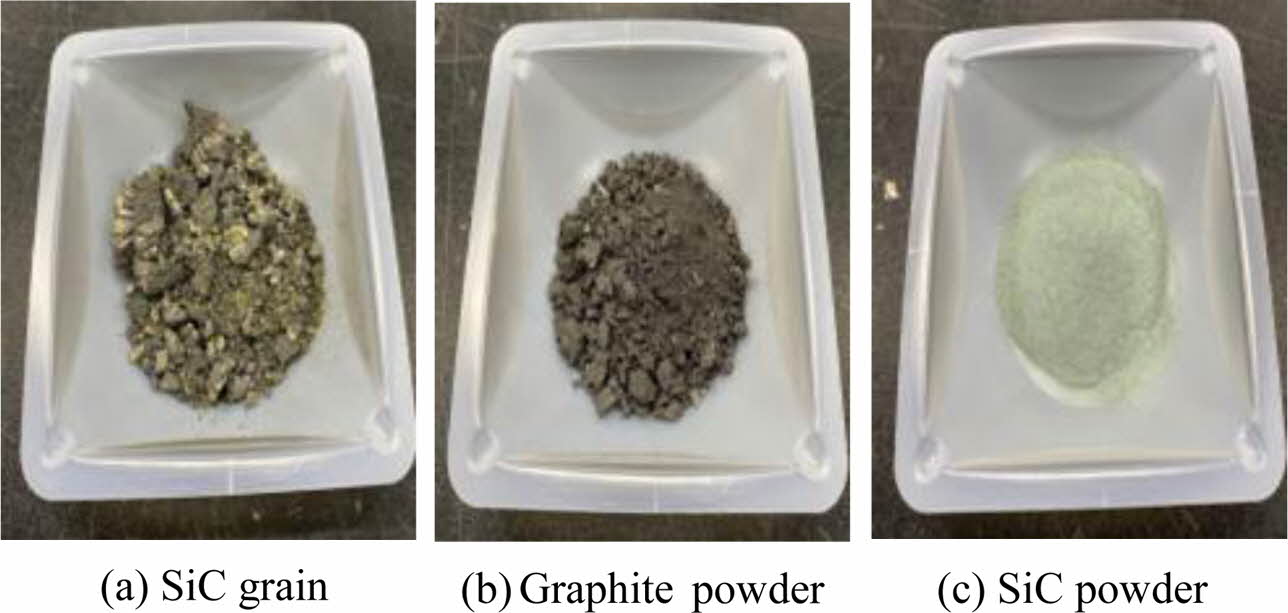
|
Fig. 1 Type of mixing material. |
Preparation of samples
We used a large mixer to mix the mortar. Moreover, we prepared mortar samples by filling 90% of the sample volume with plain mortar and the outermost 10% of the sample volume with mortar mixed with the respective EMP shielding materials.
We used a self-fabricated acrylic mold as the sample mold in the experiments. The mold dimensions were 300×300×100 mm. We filled up to 90 mm of the mold height with normal mortar, and the remaining 10 mm was filled with the mortar mixed with shielding material.
Measurement of electromagnetic shielding effecti- veness
The electromagnetic shielding effectiveness (SE) was measured using the ASTM D 3935 coaxial cable measurement method and the far-field SE measurement method for planar materials of KS C 0304.
The frequency range for the electromagnetic wave measurement was 30 MHz to 1 GHz. Moreover, the electric and magnetic fields were at right angles to each other and perpendicular to the direction of energy propagation. For the measurement method, the method that measures SE generated by absorption and reflection by planar materials under the condition of plane wave incidence of far-field was applied.
Shielding effectiveness (SE) is expressed as the log ratio of the energy of the incident electromagnetic wave to the energy of the electromagnetic wave after passing through the shielding material as shown in Eq. (1). The unit of SE is dB.

where
P1: Energy of the incident electromagnetic wave
P2: Energy of the electromagnetic wave after passing through the shielding material.
SE equal to 10 dB indicates that the energy of the incident electromagnetic wave was 10 times that of the wave after passing through the shielding material, that is, the shielding efficiency was 90%. Therefore, SE equal to 20 dB indicates a shielding efficiency of 99%, and SE equal to 30 dB indicates that of 99.9%. Fig. 2 Fig. 3 Fig. 4
Fig. 5 demonstrates the actual electromagnetic wave measurement process. We transmitted a 1 GHz electro- magnetic wave from one side of the mortar sample and measured the value of SE using a receiver on the opposite side of the mortar sample.
Electromagnetic shielding mechanism
An electromagnetic wave passing through an EMP shielding material in a fixed direction loses energy because of reflection, absorption, and refraction, as shown in Fig. 6 (Electromagnetic shielding mechanism).
Impedance difference occurs between the media through which the EM waves are transmitted during reflection, absorption, and refraction of electromagnetic waves. The EM waves lose energy via thermal loss, dielectric loss, and magnetic loss, while passing through the material. The transmission of EM waves is not possible if the material is non-uniform or thick because of the scattering of EM waves inside the material. Moreover, the EM waves are propagated in a different direction after passing through the material.
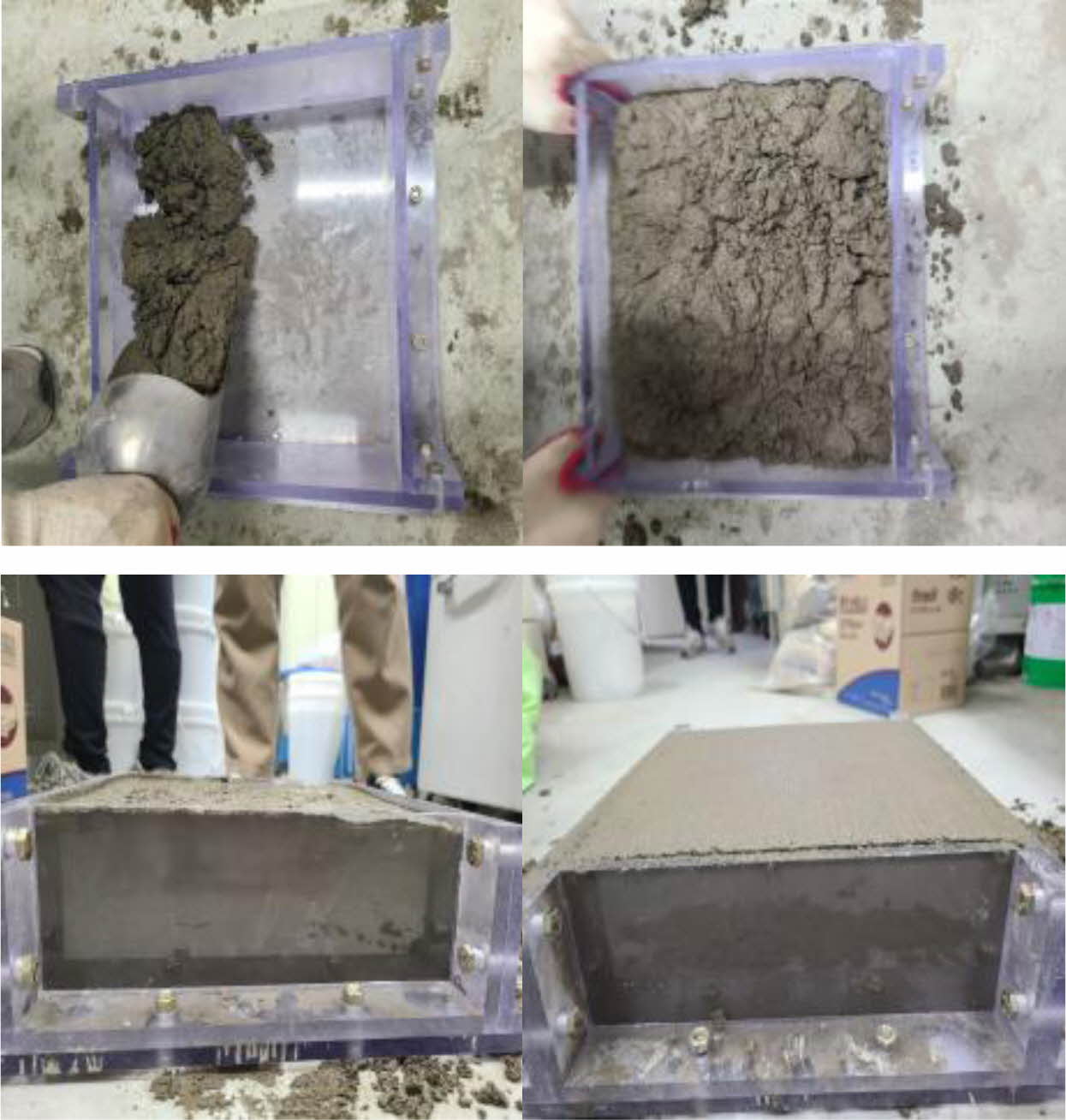
|
Fig. 2 The process of preparing the mortar sample. |
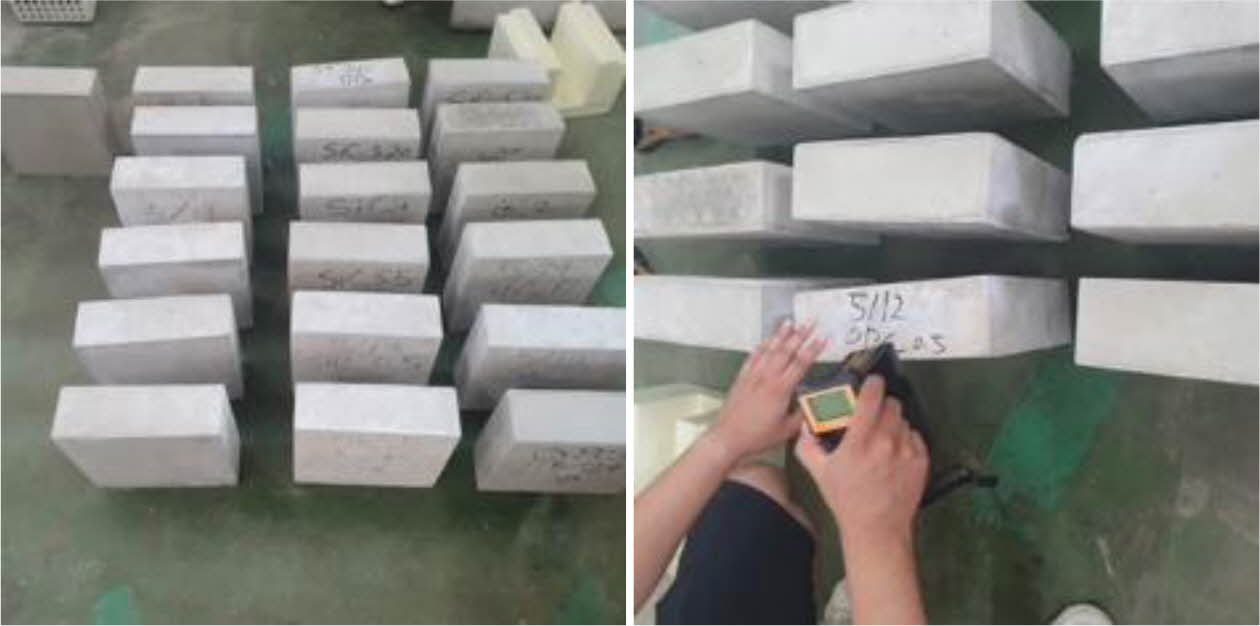
|
Fig. 3 Mortar samples with shielding materials |
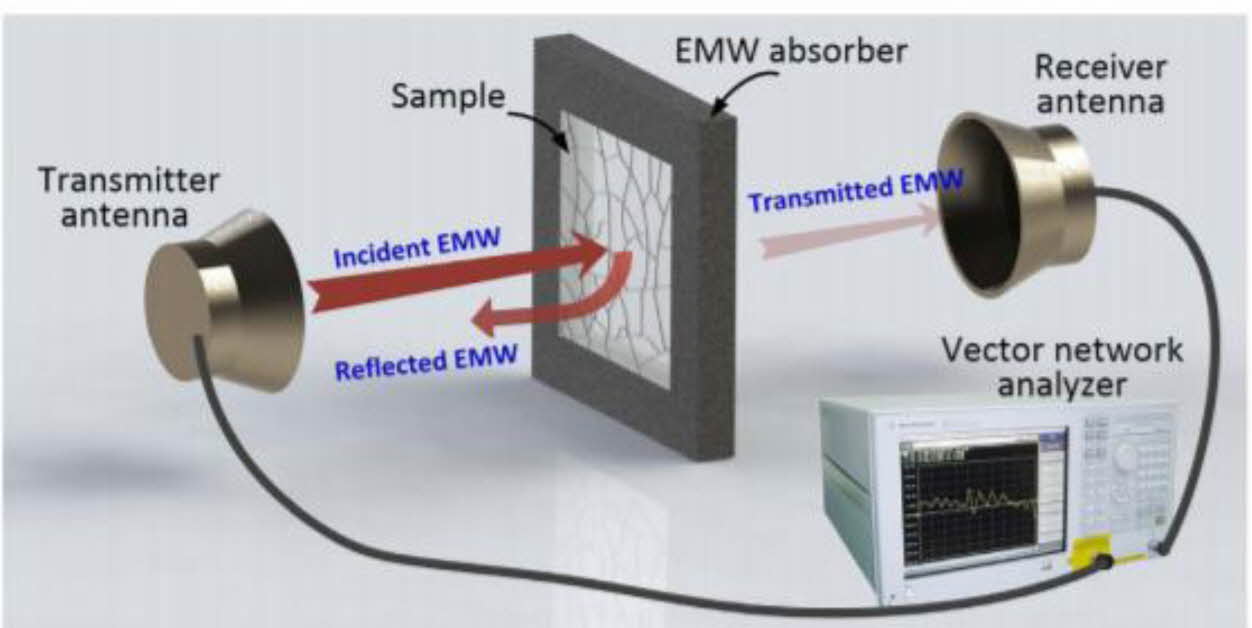
|
Fig. 4 Shielding performance evaluation process |
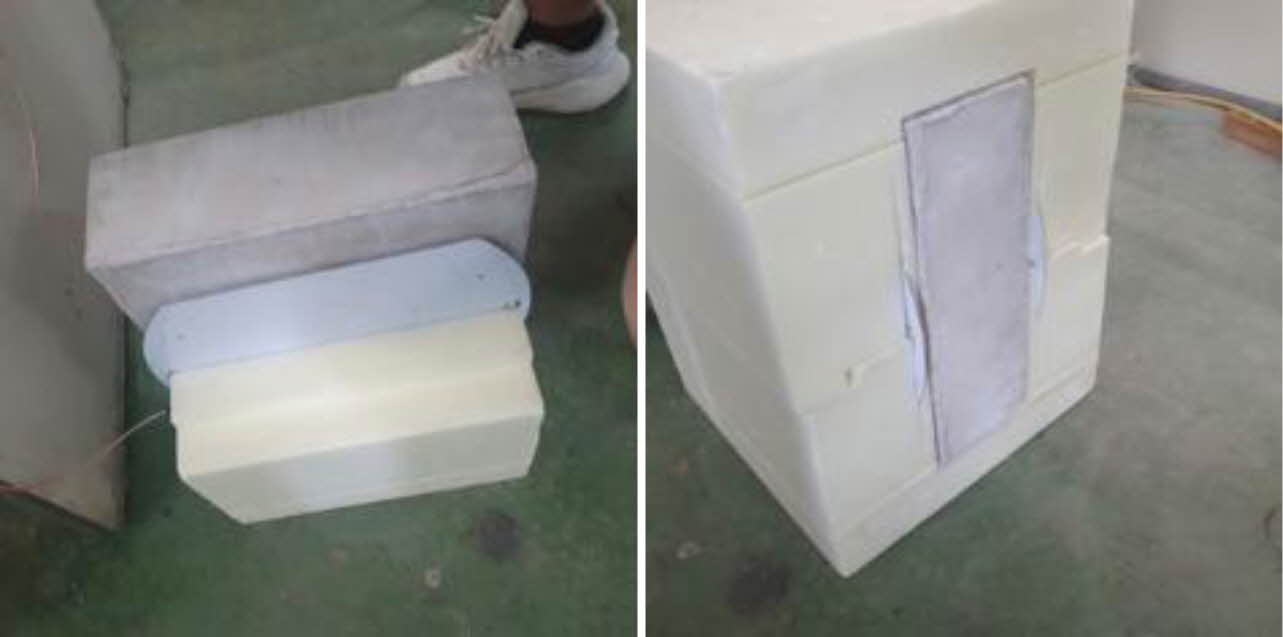
|
Fig. 5 Shielding efficiency measurement |
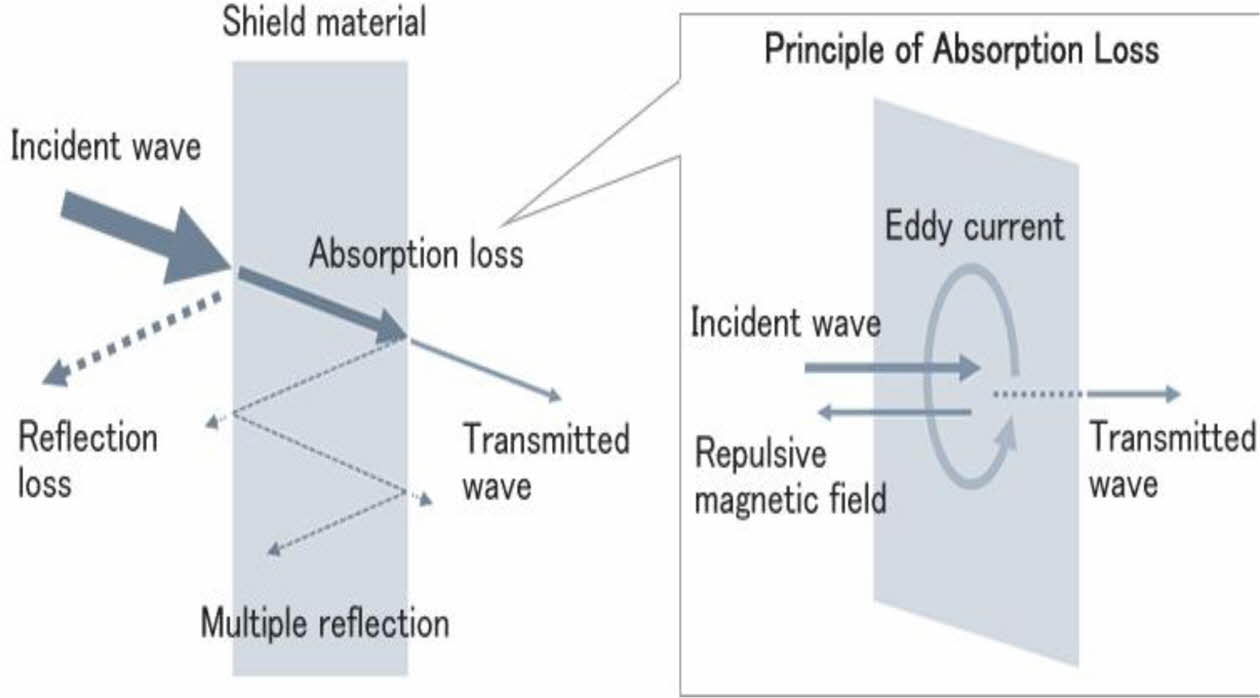
|
Fig. 6 Electromagnetic shielding mechanism. |
Shielding performance of electromagnetic wave shielding admixture
Fig. 7 illustrates the SE values of the mixtures of mortar and granular SiC. The value of SE is approximately 9-10 dB. Fig. 8 illustrates the SE values of the mixtures of mortar and graphite powder. The value of SE is approximately 8 to 10 dB. These values are approximately equal the SE values of the mixtures of mortar and granular SiC. Fig. 9 illustrates the SE values of the mixture of mortar with SiC powder. The value of SE exceeds 10 dB from the mixing proportion of 20% and 30%, and the maximum value of SE obtained was 14 dB. The highest SE values are obtained when SiC powder is mixed with mortar. In our research, 10% of the sample volume of mortar was mixed with the shielding materials. However, the mortar admixture can exhibit high EMP shielding efficiency when shielding material is mixed with the entire sample of mortar.
Results of shielding performance prediction results with the entire volume of the sample mixed with shielding material
We mixed each shielding material in the outermost 10% of the samples of mortar to determine the shielding capacity of shielding materials because shielding material is expensive. Moreover, we calculated the shielding efficiency of the samples created by mixing different shielding materials with the entire volume of the mortar sample using Eq. (1), and the results presented in Figs. 10, 11, and 12 illustrate the SE values for the different compositions of the mortar and shielding material mixtures. The results obtained using Eq. (1) established that a shielding material should be mixed with the entire volume of the mortar to obtain the highest EMP shielding efficiency. The predicted SE values from Eq. (1) of the samples of mortar mixed with granular SiC, graphite powder, and SiC powder were 20 dB, 18 dB, and 28 dB, respectively. The SE value for the sample of mortar mixed with SiC powder through its entire volume (28 dB) was approximately equal to 99.9% shielding efficiency corresponding to 30 dB. Therefore, we can obtain a mortar mixture with highest EMP shielding efficiency by mixing SiC powder with the entire volume of the mortar sample.
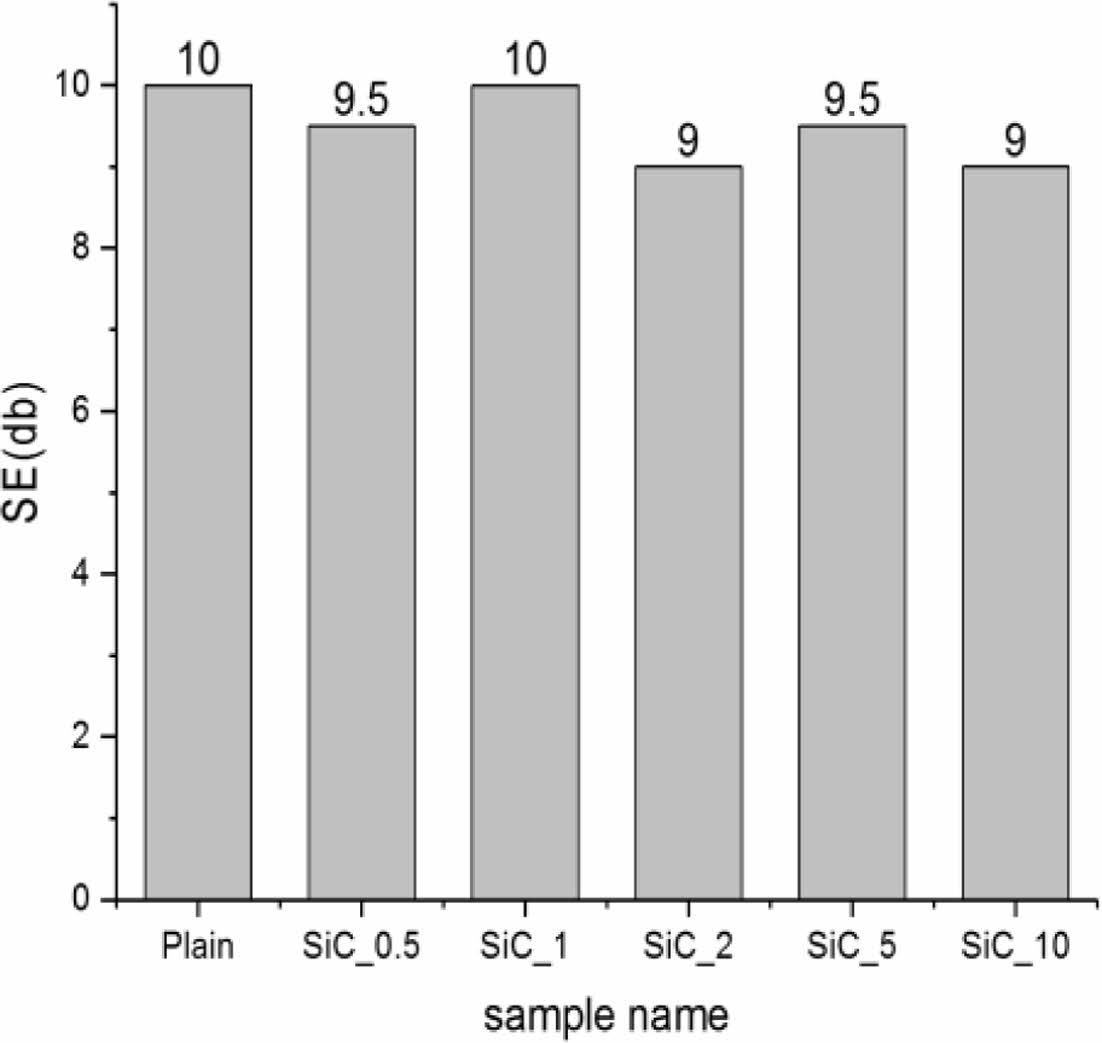
|
Fig. 7 SE values of the mortar samples mixed with granular SiC. |
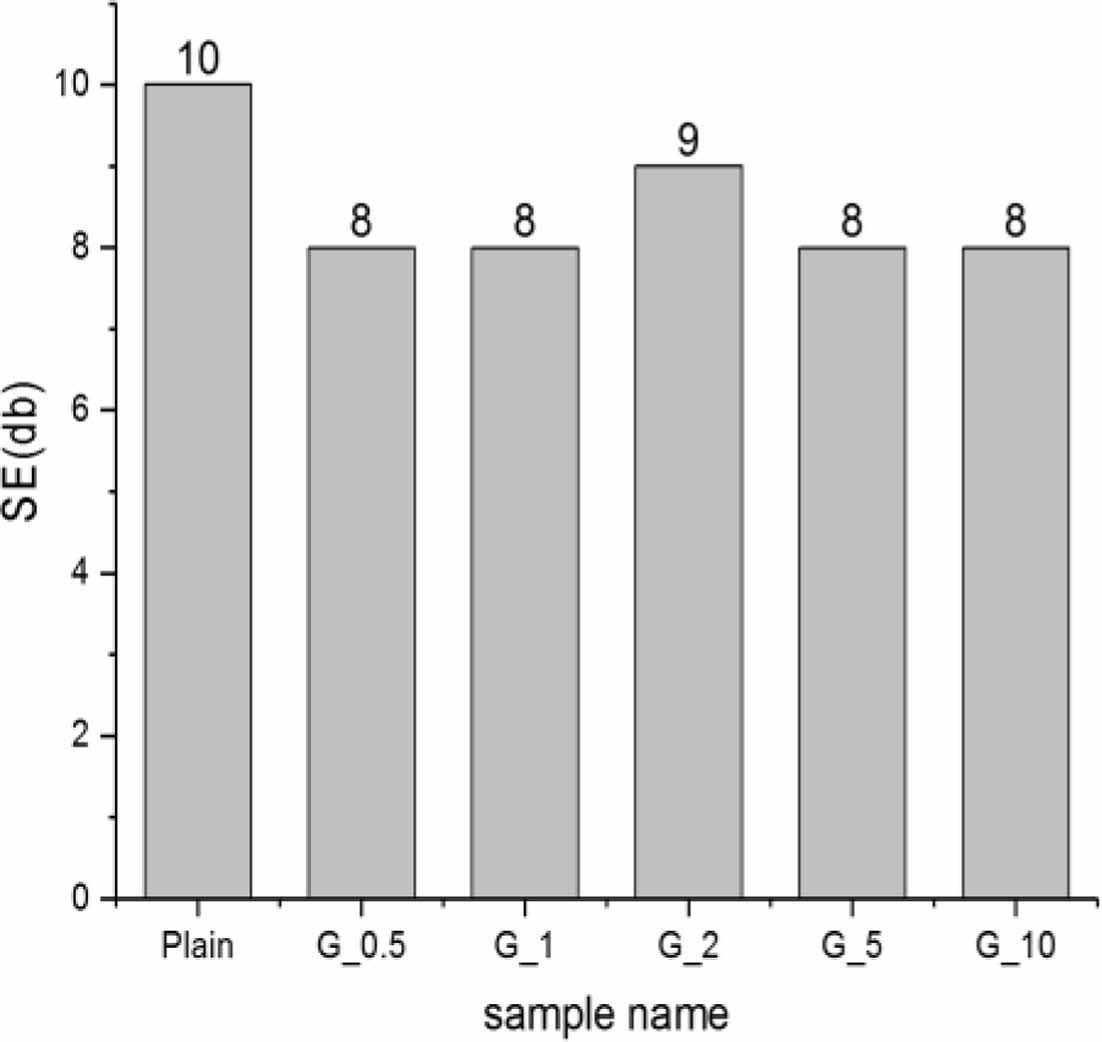
|
Fig. 8 SE values of the mortar samples mixed with graphite powder. |
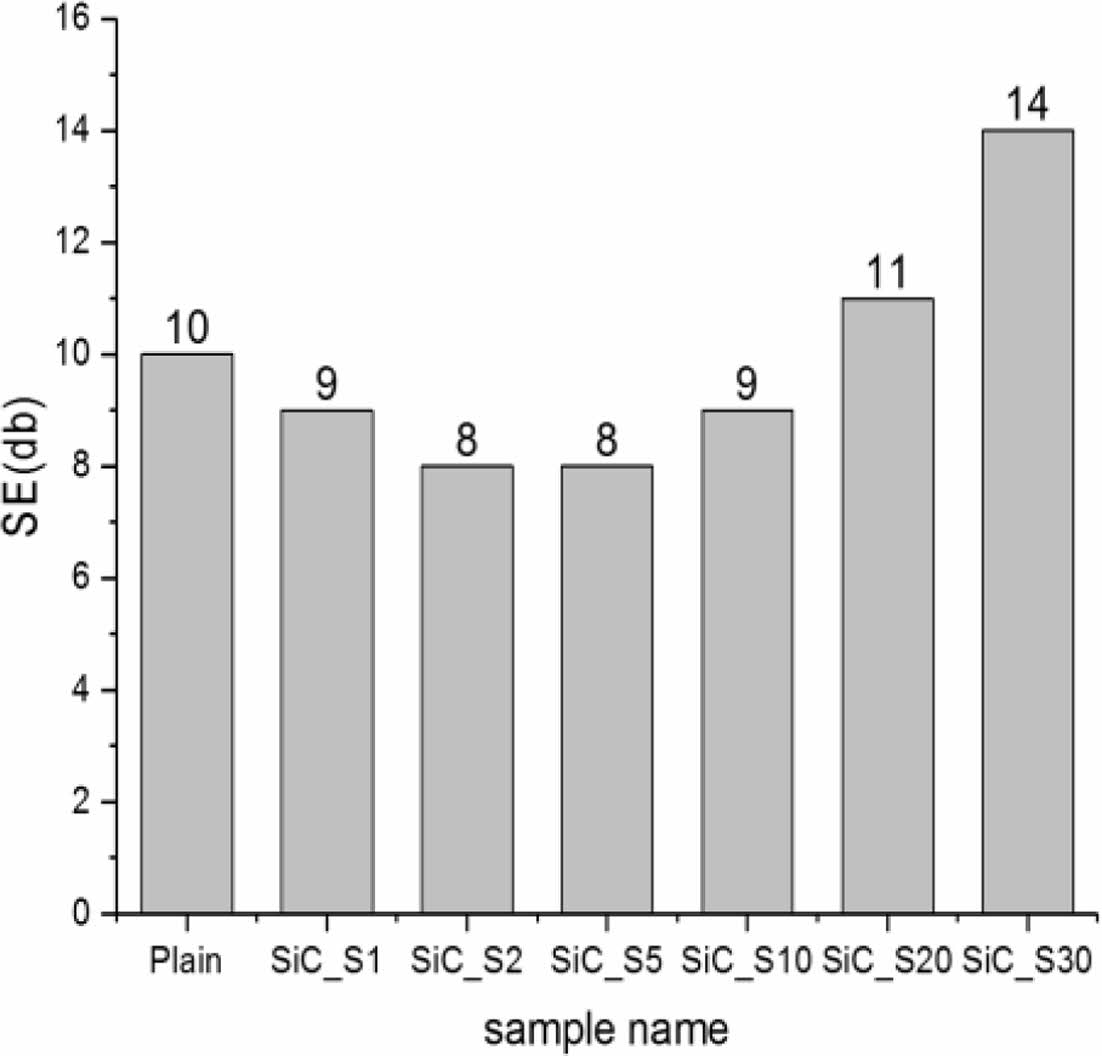
|
Fig. 9 SE values of the mortar samples mixed with SiC powder. |
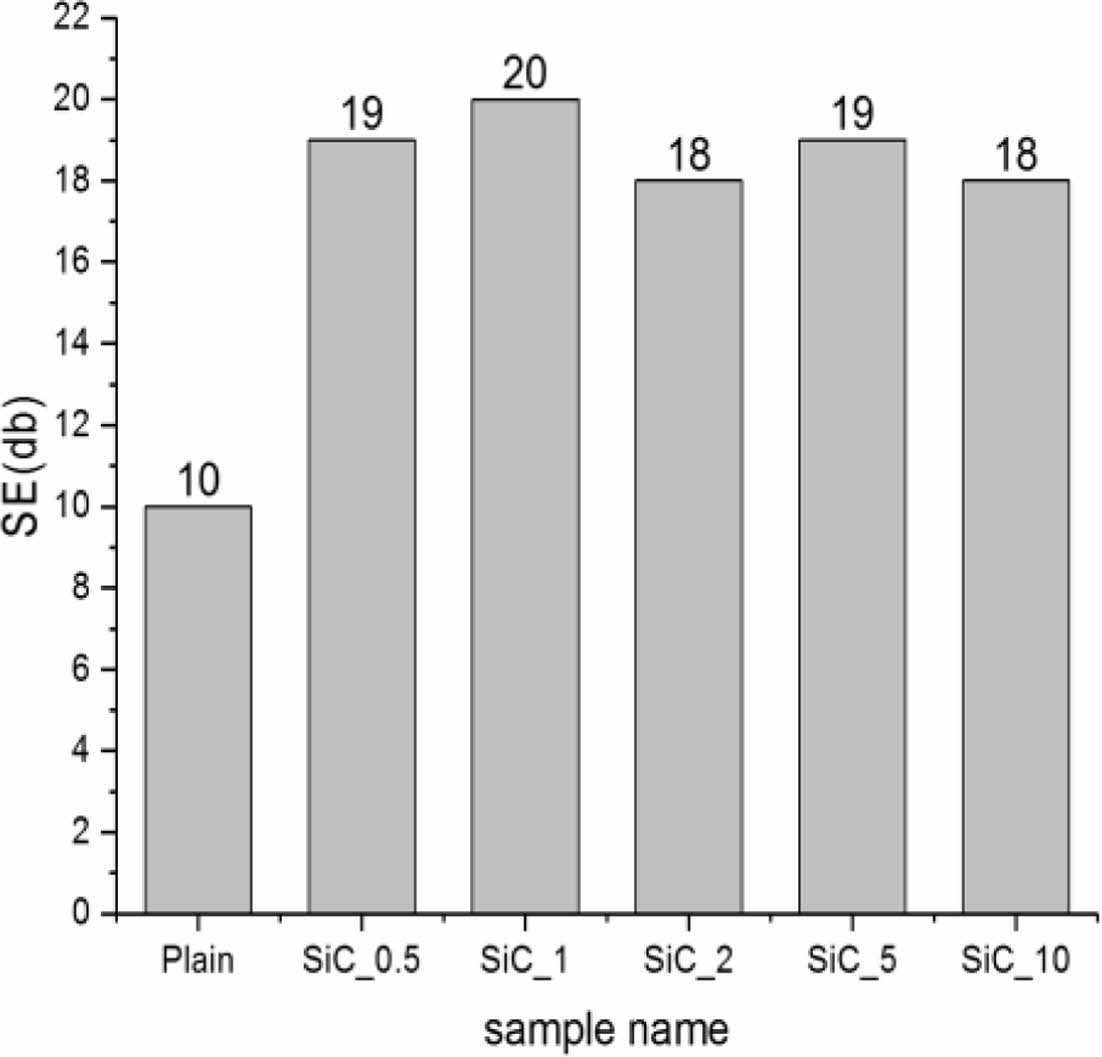
|
Fig. 10 Results of evaluation of electromagnetic shielding performance when full amount of grain SiC is mixed. |
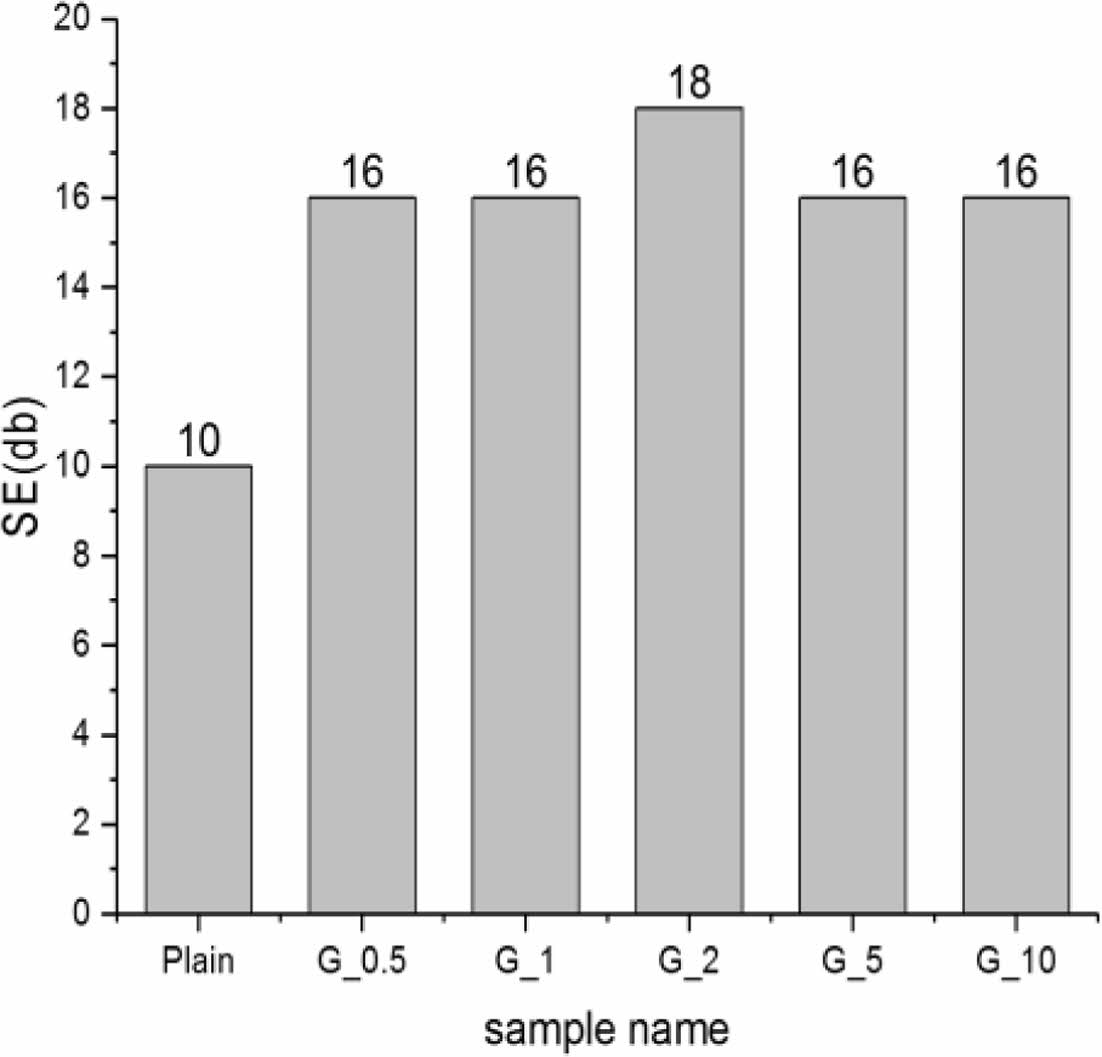
|
Fig. 11 Results of evaluation of electromagnetic shielding performance when full amount of graphite is mixed. |
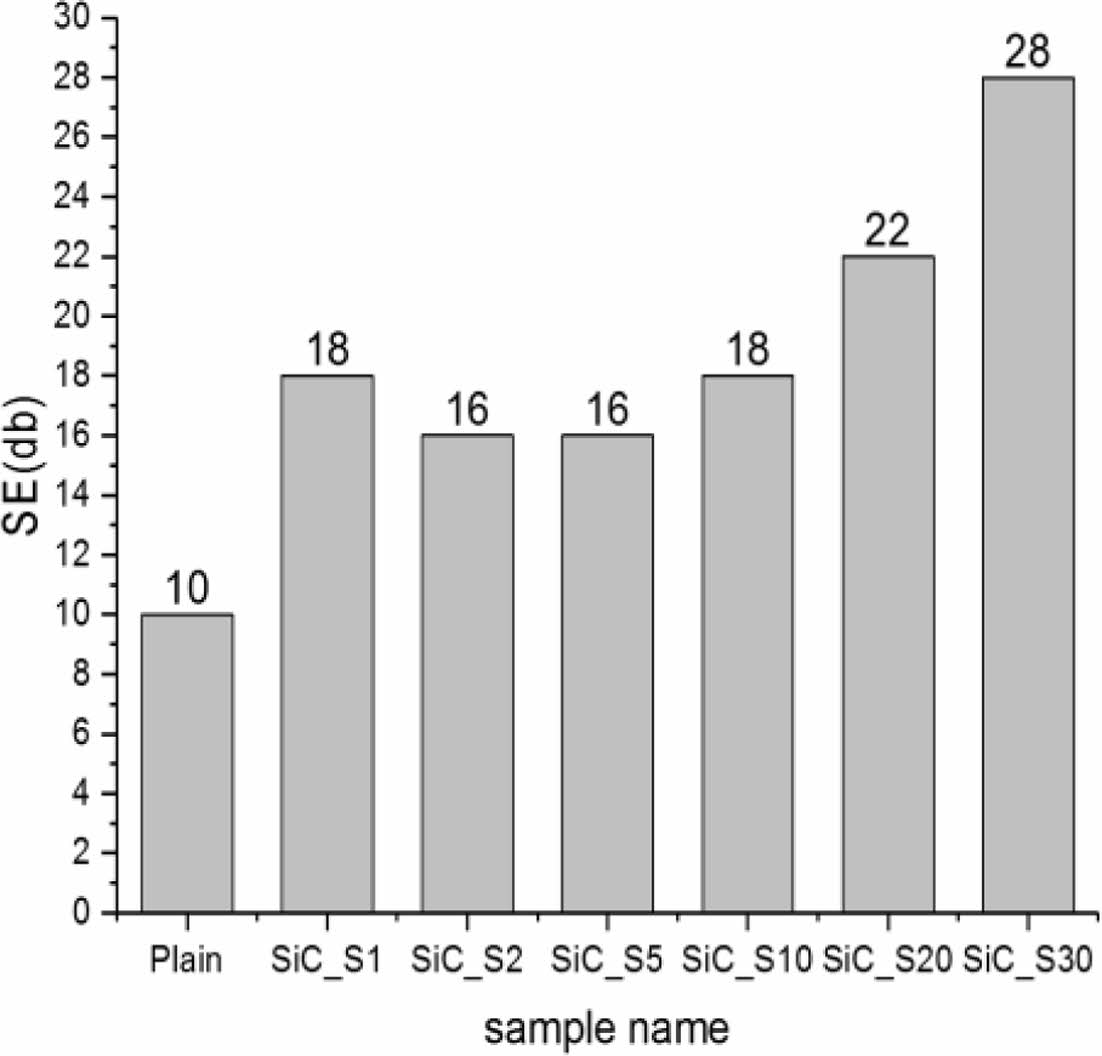
|
Fig. 12 Results of evaluation of electromagnetic shielding performance when full amount of SiC is mixed. |
We mixed granular SiC, graphite powder, and SiC powder with mortar to obtain samples of mortar with electromagnetic pulse shielding properties. However, because shielding materials, such as SiC, are expensive, we only mixed shielding materials in the outermost 10% volume of the mortar sample. Moreover, we analyzed the shielding efficiency of these samples as follows:
1) We made EMP shielding mortar samples by mixing the outermost 10% volume of mortar samples with shielding materials. The SE values of the mortar samples mixed with granular SiC, graphite powder, and SiC powder are 10 dB, 9 dB, and 14 dB, respectively. However, these mortar samples do not provide adequate EMP shielding. Therefore, the mortar samples with the outermost 10% volume mixed with shielding materials cannot be used in practical applications.
2) We predicted the SE values of the mortar samples prepared by mixing different shielding materials with the entire volume of mortar using the SE formula. The predicted SE of the mortar samples mixed with granular SiC, graphite powder, and SiC powder throughout the volume of the mortar were 20 dB, 18 dB, and 28 dB, respectively. The SE value for the sample of mortar mixed with SiC powder through its entire volume (28 dB) was approximately equal to 99.9% shielding efficiency corresponding to 30 dB.
3) The highest value of SE was obtained when SiC powder was mixed with the entire volume of the mortar sample. The admixture using granular forms of shielding materials exhibit lower dispersion compared to the admixture using the powdered form of shielding materials. Graphite powder exhibits excellent electrical conductivity; however, the EMP shielding efficiency of graphite powder is low. SiC powder provides the highest EMP shielding efficiency.
This manuscript has not been published or presented elsewhere in part or in entirety and is not under consi- deration by another journal.
We acknowledge that this research was funded by the Construction Technology Research Project (Project Number: 20CTAP-C157556-01) of the Ministry of Land, Infrastructure.
- 1. H.J. Choi, H.C. Kim, S.W. Lim, and H.S. Lee, KCI 29[2] (2019) 169-177.
-

- 2. M.J. Seo, S.W. Chi, Y.J. Kim, W.C. Park, H.J. Kang, and C.S. Huh, KIEES 25[2] (2014) 548-558.
-

- 3. H.G. Kim and H.K. Lee, KCI 20[6] (2008) 70-74.
-

- 4. K.-J. Kim, S.-W. Park, J.-W. Baek, and Y.-J. Park, KCI 19[2] (2019) 193-200.
-

- 5. H.J. Ahn, S.H. Kim, and S.K. Choi, Journal of the Korea Institute of Building Construction, 16[3] (2016) 247-255.
-

- 6. S.H. Kang and J.S. Koo, Korea Ready Mixed Concrete Industry Association 61[10] (1999) 36-51.
-

- 7. S.C. Kim, in “Final Version of Development of Electro- magnetic Shielding and Absorption Functional Concrete Report” (Korea Construction and Transportation Technology Evaluation Institute, 2007).
- 8. B.W. Jo J.S. Choi, and S.W. Kang, J. Ceram. Process. Res. 12[3] (2011) 294-298.
- 9. Y.S. Lee D.S. Lim, B.S. Chun, and J.S. Ryou, J. Ceram. Process. Res. 14[1] (2013) 87-91.
 This Article
This Article
-
2022; 23(2): 165-170
Published on Apr 30, 2022
- 10.36410/jcpr.2022.23.2.165
- Received on Sep 1, 2021
- Revised on Nov 29, 2021
- Accepted on Dec 4, 2021
 Services
Services
- Abstract
introduction
literature review
materials and mixing proportions
experiment
results and discussion
conclusion
- Conflict of Interest
- Acknowledgements
- References
- Full Text PDF
Shared
 Correspondence to
Correspondence to
- Hyeong-Kyu Cho
-
Senior Researcher, Energy and Environmental Division, Korea Institute of Ceramic Engineering and Technology, Jinju Korea
Tel : +82-55-792-2472 Fax: +82-55-792-2469 - E-mail: hkcho@kicet.re.kr






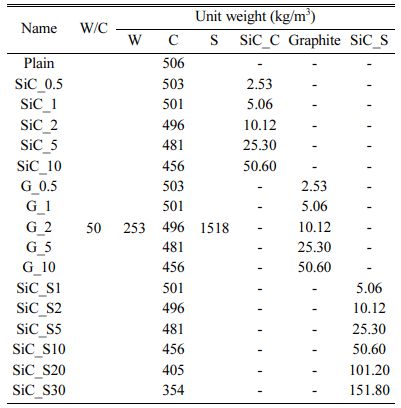
 Copyright 2019 International Orgranization for Ceramic Processing. All rights reserved.
Copyright 2019 International Orgranization for Ceramic Processing. All rights reserved.